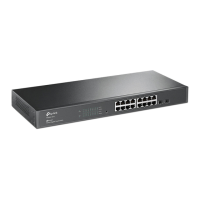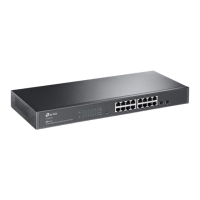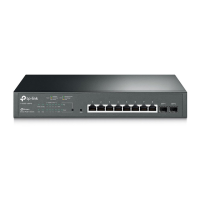47
1) Connecting the stack members
To establish a stack, please physically connect the stack ports of the member devices with
cables. The stack ports of T1700G-28TQ can be used for stack connection or as normal SFP+
port. When you want to establish a stack, the stack capability of the related SFP+ ports should
be configured as "Enable". If the stack capability of the port is "Disable", then the port will work
as a normal SFP+ port.
Stack typically adopts a daisy chain topology or ring topology as shown in Figure 5-6:
Figure 5-6 Stack Connect Topology
• The daisy chain topology is mainly used in a network where member devices are
distributively located.
• The ring topology is more reliable than the daisy chain topology. In a daisy chained stack,
link failure can cause stack split. While in a ring connected stack, the system is able to
operate normally with a new daisy chained topology.
Note:
Establish a stack of ring or daisy chain topology with six T1700G-28TQ switches at most.
2) Topology Collection
Each member in the stack collects the topology of the whole stack by exchanging stack
discovery packets with its neighbors. Discovery packet carries topology information including
stack port connection status, unit number, priorities, MAC addresses, etc.
Each member keeps a local record of the known topology information. When the device
initializes, it only possesses the record of its own topology information. Periodically the stack
members send out their known topology information through the stack ports to its neighbors.
When the neighbors receive the information, they will update their local topology information.
After a period of time of broadcasting and updating information, all the stack members can
collect the complete topology information (known as topology convergence).
Then the switch enters the master election stage.
3) Master Election
After all members have obtained topology information (known as topology convergence), the
stack enters the master election stage. A stack always has one stack master, while the other
stack members are stack members. Master election determines the stack role of the stack
members.
Master election is held each time the topology changes, for example, when stack merge or
split occurs, or the stack or the current master is reset.

